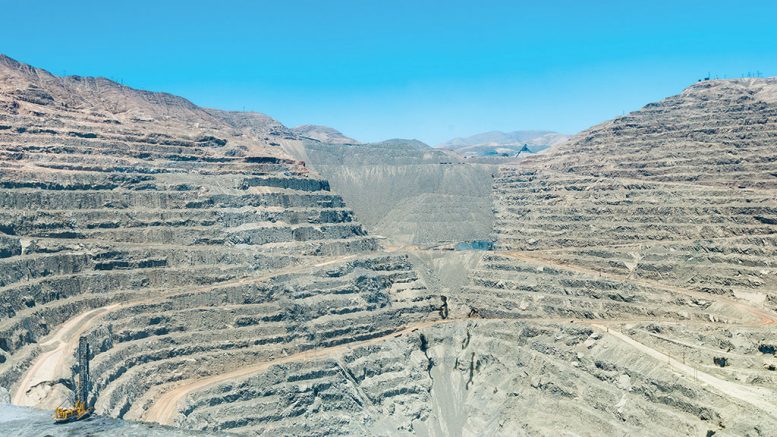VANCOUVER — Lundin Mining (TSX: LUN) pulled together a management conference call after a press release detailing its lower production guidance for the next three years triggered a fall in its share price on the Toronto Stock Exchange.
President and CEO Paul Conibear said the company “clearly didn’t communicate well enough” about the strategy behind its revised outlooks for production and capital expenses that Canaccord Genuity analyst Dalton Baretto called “weak across the board.”
On Nov. 29, Lundin released guidance on its production, cash costs, and capital and exploration expenses for 2018-2020.

The Candelaria and Ojos del Salado mines, and surrounding tenements, are located in Chile’s Atacama Province, Region III, at an elevation of approximately 650 metres above sea level, 20 km south of the city of Copiapó. Credit: Lundin Mining.
Perhaps the biggest surprises were lower near-term production outlooks, and higher capital expenses at the company’s flagship, 80%-owned Candelaria copper complex in Chile’s Atacama region.
Lundin unveiled a 10-year plan at Candelaria that could bring short-term pain — but pay off in the long-term.
The company expects the operation will produce between 104,000 and 109,000 tonnes of attributable copper production next year, or a 20% decrease from previous estimates.
In addition, Lundin boosted capital expenses at Candelaria to $2.2 billion over 10 years, and said it will spend $510 million at the operation in 2018.
The company’s global capital expense guidance for 2018 rose 77% to US$850 million.
“Capital expenditures are up significantly next year. The Candelaria investment is the largest, but some of the capital in there will lower our long-term operating costs and result in the production of more copper,” Conibear said during the Dec. 1 conference call.
“We’ve significantly extended the life and improved the production profile. That has involved rephasing of the pit and reinvesting in the large mine fleet to ensure our production requirements are met in the long-term. It also gives us flexibility in operating the underground, open pit and the mill,” he added.
Furthermore, the company reported that Candelaria’s 2018 production was impacted by a recent slide in sections of the open pit, which has forced it to “take a more conservative approach” in mining the area.
Lundin stressed that forecast copper production over the next 10 years has “increased in aggregate” by 290,000 tonnes, which equates to a 20% improvement.

Underground in Lundin Mining’s Neves-Corvo pollymetallic mine in Portugal. Photo by Lundin Mining.
The company also lowered guidance at its Neves-Corvo copper-zinc mine in southern Portugal, and its Zinkgruvan zinc-copper mine in south-central Sweden.
Lundin is funding a US$245-million zinc expansion project at Neves-Corvo in 2018.
The operation is now expected to produce between 39,000 and 44,000 tonnes attributable copper, and between 68,000 tonnes and 73,000 tonnes zinc in 2018. Lundin anticipates the expansion initiative, however, will boost total zinc production by 60% in 2020.
Zinkgruvan is expected to generate between 76,000 and 81,000 tonnes zinc next year, or an 8% drop from previous guidance.
Lundin will spend US$40 million at the mine in 2018, which will include underground development and mine and plant maintenance, and improvement initiatives. The company says it is focused on improving metal recoveries and concentrate quality.
The Zinkgruvan zinc-copper mine is 250 km southwest of Stockholm in south-central Sweden, 15 km from the town of Askersund. It comprises a deep underground mine, a processing plant and associated infrastructure and tailings disposal facilities.
“We’re obviously down on copper for next year,” Conibear said. “That’s clearly a concern to many investors, and likely the key element that resulted in our significant stock decline … our number-one priority is adding value through prudent management and investments in our own assets. If you take a look at each one of our operations you can see we’re reinvesting in them. Looking three years ahead you’ll see progressive improvement in production of all the metals, from all our mines, due to these investments.”
Lundin now anticipates total 2018 production ranging from 159,000 to 173,000 attributable copper, and 144,000 to 154,000 tonnes total zinc.
The company said by 2020 it will be producing between 187,000 and 201,000 tones copper and 234,000 and 244,000 tonnes total zinc.
Lundin did not report any changes at its Eagle polymetallic mine in Michigan, which is expected to contribute between 14,000 and 17,000 tonnes nickel in 2018.

The Zinkgruvan zinc and copper mine is located around 250 km southwest of Stockholm in south-central Sweden. The mine site is some 15 km from the town of Askersund and comprises a deep underground mine, a processing plant and associated infrastructure and tailings disposal facilities. Credit: Lundin Mining.
Conibear also said the increased capital outlays will “not change whatsoever.”
Regarding possible mergers and acquisitions opportunities, he said Lundin Mining has been “more active than ever” and that it completed three full-on due diligence processes over the past year, but added it was difficult to find high-quality assets.
“We’ll continue on and be very active in the near- and medium-term. None of our internal investments on assets will compete with value-add, external growth opportunities,” he said.
Canaccord’s Baretto downgraded Lundin from a “buy” to a “hold” recommendation after the news, and slashed his price target by $1.50 to $9 per share.
BMO Capital Markets analyst Alex Terentiew downgraded Lundin to “market perform” and lowered his target price by $1.25 to $10 per share. He said the company “remains strong” with an “attractive asset base and balance sheet,” but the near-term grade and spending profile at Candelaria “have moderated our near-term expectations.”
Lundin shares dropped nearly 20% on 87 million shares traded on Nov. 30 and Dec. 1 before closing at $7.22 per share at press time. The company has 728 million shares outstanding for a $5.3-billion market capitalization, and reported US$2.15 billion in cash and equivalents at the end of September.


LOOK AT THE LONG TERM!